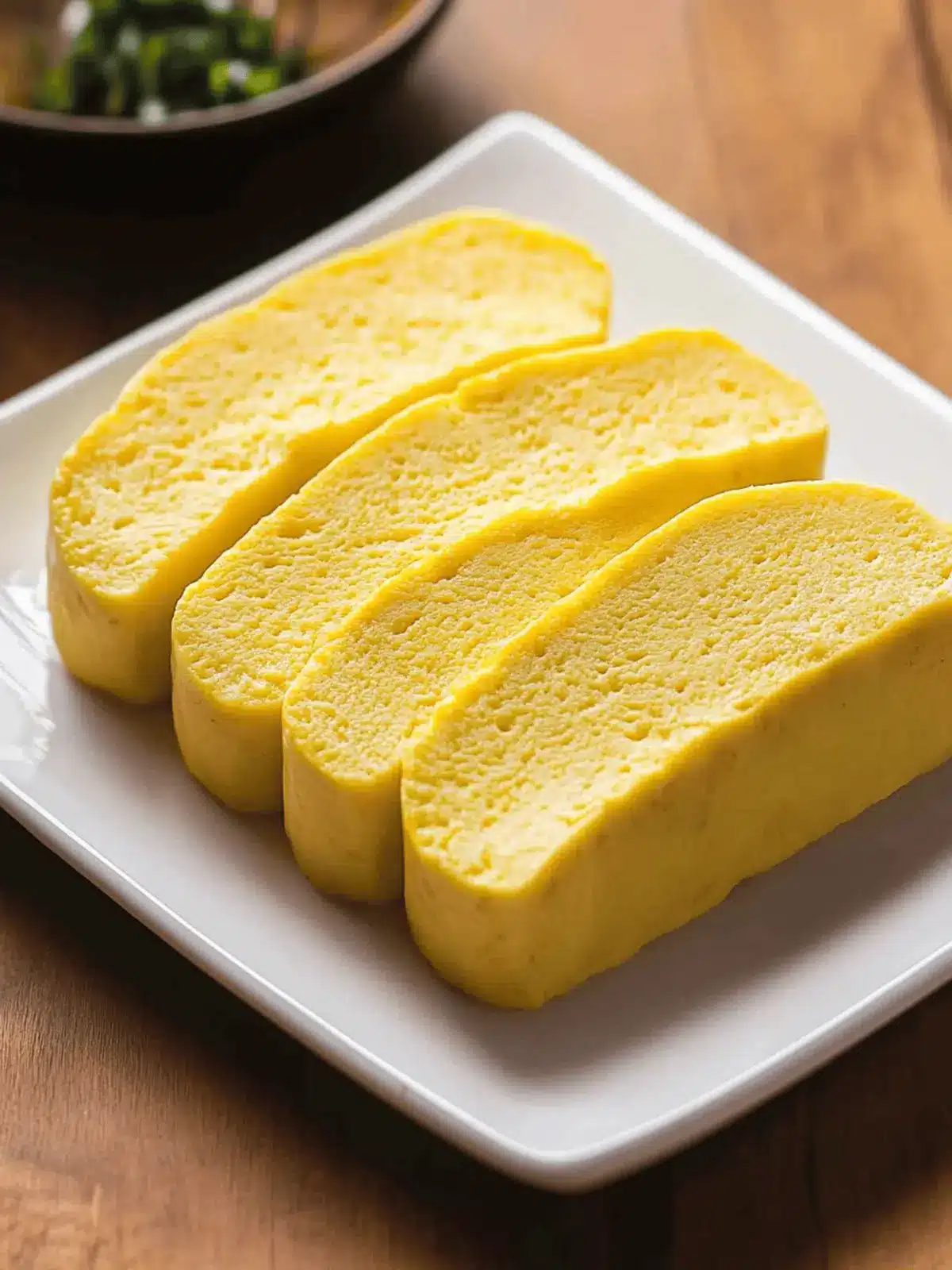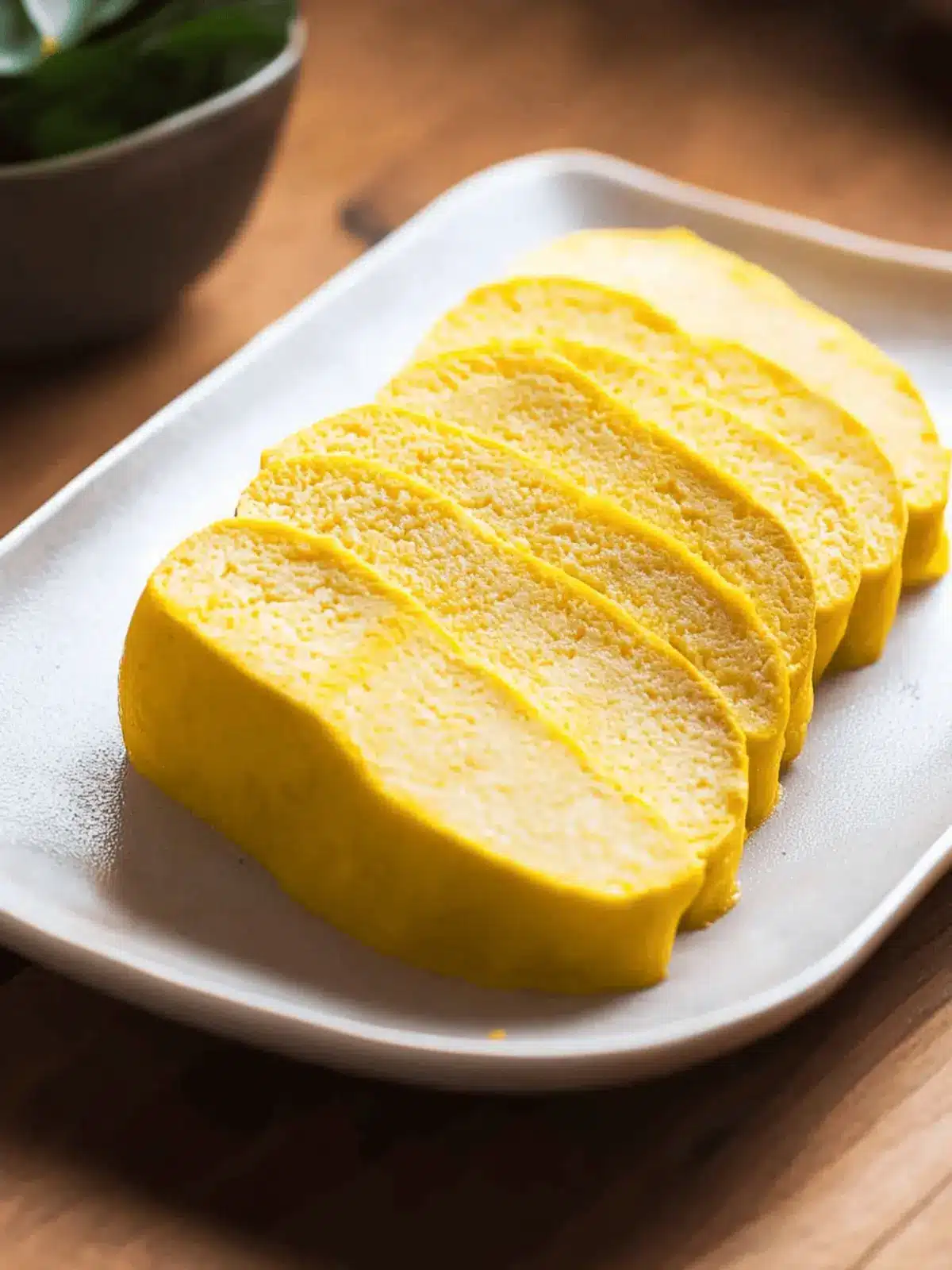Imagine the warmth of a perfectly cooked omelet unveiling layers of soft, fluffy goodness, each bite a delightful blend of savory and sweet. That’s the magic of Tamagoyaki, the beloved Japanese rolled omelet that has graced tables across Japan for generations. I first experienced its charm during a visit to a quaint sushi spot, where the chef expertly crafted this dish right before my eyes. Now, I want to share an easy, three-ingredient version that lets you replicate that unforgettable taste at home without needing special skills or intricate ingredients.
With just eggs, water, and memmi sauce, you can whip up this delightful side dish that transforms any meal into a culinary adventure. Perfect for a quick breakfast, as a bento box addition, or even as a snack, this Tamagoyaki recipe is versatile and sure to please anyone looking to escape the monotony of fast food. Let’s dive in and bring a taste of Japan straight to your kitchen!
Why is Tamagoyaki so beloved worldwide?
Simplicity and Accessibility: This recipe requires only three ingredients—eggs, water, and memmi sauce—making it easy for anyone to prepare.
Fluffy Texture: Each layer of the omelet is soft and airy, delightful to bite into!
Versatile Dish: Enjoy it as a side dish, in sushi rolls, or as part of your breakfast; the options are endless.
Culinary Adventure: You’ll feel like a skilled chef crafting this Japanese delicacy right in your home, thanks to its straightforward technique.
Crowd-Pleasing Results: Perfect for impressing guests or family, the beautiful layers and taste are sure to win hearts.
For more helpful tips on maximizing flavor, check out our guide on Japanese culinary essentials.
Tamagoyaki Ingredients
For the Omelet
• Eggs – The star of the dish; use fresh, large eggs for the fluffiest texture.
• Water – Adds moisture for a soft consistency; adjust to your liking for more fluffiness.
• Memmi Sauce – Delivers umami and sweetness; substitute with low-sodium soy sauce and sugar if you’re out of memmi.
For Cooking
• Oil – Prevents sticking and creates a golden crisp exterior; sesame oil can enhance the flavor.
With these simple Tamagoyaki ingredients, you’re just moments away from creating a deliciously memorable dish!
How to Make Tamagoyaki
-
Prep the Egg Mixture: In a mixing cup, combine the eggs, water, and memmi sauce. Whisk everything together until evenly blended; for an ultra-smooth texture, consider straining the mixture.
-
Heat the Pan: Preheat your tamagoyaki or a nonstick pan over medium heat while lightly oiling it. Keep the heat moderate to avoid burning the eggs.
-
Cook the Omelet Layers: Pour a thin layer of the egg mixture into the pan. Gently scramble for the first few seconds and, when it’s about 70% cooked, roll the omelet to one side of the pan.
-
Add More Layers: Lightly re-oil the pan and pour in another layer of the egg mixture, lifting the set omelet to allow the liquid to flow underneath. Repeat this process until all the mixture is cooked and rolled.
-
Slice and Serve: Remove the rolled omelet from the pan and let it cool for a few minutes. Once it’s set, slice it into pieces and serve warm for the best experience.
Optional: Garnish with sliced scallions or sesame seeds for an extra burst of flavor.
Exact quantities are listed in the recipe card below.
Tips for the Best Tamagoyaki
-
Use the Right Pan: A tamagoyaki pan offers the best results, but any nonstick skillet will do. Just ensure it’s lightly oiled to prevent sticking.
-
Watch Your Heat: Moderate heat is crucial. Too high will burn the eggs, while too low may not set them properly. Look for a slightly wet surface before rolling.
-
Roll Firmly: When creating layers, roll the omelet tightly to avoid unwanted gaps. This ensures those beautiful, fluffy layers stay intact in your Tamagoyaki.
-
Experiment with Add-Ins: Spice things up by adding finely chopped green onions, or even shredded nori, to your egg mixture for extra flavor.
-
Let It Cool: After cooking, allow the omelet to cool slightly before slicing. This will help it hold its shape and texture better.
Make Ahead Options
These Tamagoyaki are perfect for meal prep enthusiasts! You can whisk together the egg mixture (eggs, water, and memmi sauce) up to 24 hours in advance and store it in an airtight container in the refrigerator. Additionally, once cooked, you can refrigerate the Tamagoyaki for up to 3 days. To maintain its delightful texture, cover it well with plastic wrap or store it in an airtight container to prevent it from drying out. When you’re ready to serve, simply reheat gently in a nonstick pan over low heat, slicing it just before serving for that fluffy, restaurant-quality result. Enjoy the ease of having this delicious side dish ready to go during busy weeknights!
What to Serve with Tamagoyaki?
Creating a well-rounded meal around your fluffy Japanese omelet can transform your dining experience into something extraordinary.
-
Steamed Rice: This classic pairing balances the Tamagoyaki’s sweet-savory layers with light, fluffy rice, creating a satisfying bite. Whether served warm or at room temperature, rice enhances the dish’s overall comfort.
-
Miso Soup: A warm bowl of miso soup offers a deeply comforting contrast, with its umami richness harmonizing beautifully with the delicate flavors of Tamagoyaki. This combination brings a bit of Japanese tradition to your table, both nourishing and filling.
-
Pickled Vegetables: Add a touch of acidity with tangy, pickled veggies. Their crunch complements the soft texture of the omelet, making each bite a delightful adventure for your palate.
-
Sliced Scallions: A fresh garnish of sliced scallions not only adds a pop of color but also a hint of sharpness that contrasts the mellow sweetness of Tamagoyaki, enhancing the overall flavor profile.
-
Seaweed Salad: This refreshing side adds a briny crunch that elevates your meal experience. The flavors of seaweed salad work beautifully, adding a layer of complexity to each bite of the rolled omelet.
-
Chilled Sake: Pair your Tamagoyaki with a glass of chilled sake for a refreshing drink option. The light, crisp taste of sake complements the dish without overpowering it, enhancing that authentic dining experience.
-
Fresh Fruits: End your meal with seasonal fresh fruits like juicy melons or plump strawberries. Their natural sweetness provides a delightful contrast to the savory Tamagoyaki, cleaning the palate beautifully.
Tamagoyaki Variations
Feel free to explore these delightful twists and substitutions to create your perfect Tamagoyaki experience.
-
Vegetarian Delight: Add finely chopped mushrooms or bell peppers to the egg mixture for a fresh, earthy taste. The sautéed veggies bring a burst of flavor and texture that complements the sweetness of the Tamagoyaki beautifully.
-
Herbaceous Twist: Incorporate fresh herbs like cilantro or chives into the egg mix for an aromatic boost. The bright flavors will add an exciting dimension, making each bite feel like a new adventure!
-
Seafood Infusion: Toss in tiny bits of crabmeat or cooked shrimp. This savory addition enhances the umami profile and elevates your Tamagoyaki to a restaurant-quality dish.
-
Spicy Kick: Stir in a pinch of red pepper flakes or a drizzle of sriracha for those who crave a bit of heat. This variation adds a delightful contrast to the sweet and savory notes of the omelet.
-
Sweet Variation: For a sweeter take, mix in 1 tablespoon of sugar or a splash of mirin into the egg mixture. This will create layers that are not only fluffy but also tantalizingly sweet, perfect for breakfast!
-
Japanese Classic: Try adding a splash of dashi (if available) into the egg mix. While it deviates from the three-ingredient focus, this traditional touch enhances the authentic flavor you’re aiming for.
-
Nori Crunch: Fold in small strips of nori into the cooked Tamagoyaki for an umami-laden surprise. This seaweed addition will offer a unique textural component and an essence of the ocean!
-
Nutty Flavor: Swap out the cooking oil for sesame oil to infuse an aromatic, nutty quality. This simple switch transforms the dish, adding depth without overwhelming the beloved traditional flavor.
Whichever variation you choose, each bite of Tamagoyaki is a journey into the heart of Japanese comfort food!
Storage Tips for Tamagoyaki
-
Fridge: Keep your Tamagoyaki in an airtight container, and it will stay fresh for up to 3 days. This way, it retains its delightful texture and flavor.
-
Freezer: For longer storage, wrap the Tamagoyaki tightly in plastic wrap and place it in a freezer-safe bag. It can last up to 2 months in the freezer.
-
Reheating: To enjoy your Tamagoyaki, gently reheat it in a nonstick skillet over low heat. This will help maintain its softness and prevent it from drying out.
-
Room Temperature: If serving at room temperature, consume the Tamagoyaki within 2 hours after cooking for optimal taste and safety.
Tamagoyaki Recipe FAQs
How do I select the best eggs for Tamagoyaki?
When making Tamagoyaki, always choose fresh, large eggs for the best flavor and texture. Look for eggs that are clean and have no cracks, and a good indicator of freshness is a date on the carton that is still in the future. Fresh eggs will give you that fluffy, delicate texture that’s ideal for this rolled omelet.
How should I store leftover Tamagoyaki?
Store your Tamagoyaki in an airtight container in the refrigerator, where it will stay fresh for up to 3 days. This helps maintain the soft texture and rich flavor. Just ensure it has cooled to room temperature before sealing it up, as this will prevent condensation and retain its delightful taste.
Can I freeze Tamagoyaki for later use?
Absolutely! To freeze your Tamagoyaki, wrap each piece tightly in plastic wrap, then place it inside a freezer-safe bag. This can be stored in the freezer for up to 2 months. When you’re ready to enjoy it, gently reheat in a nonstick skillet over low heat until warmed through, ensuring it stays soft and doesn’t dry out.
What should I do if my Tamagoyaki doesn’t roll properly?
If your Tamagoyaki isn’t rolling as it should, it might be due to the egg mixture not being cooked enough before starting to roll. Make sure to let each layer set about 70% before rolling it to ensure it holds its shape. Additionally, don’t hesitate to experiment with the thickness of each layer; a thinner layer makes rolling easier!
Is Tamagoyaki safe for people with egg allergies?
Since Tamagoyaki is primarily made of eggs, it is not suitable for those with egg allergies. If you’re looking for a similar dish, consider trying vegetable-based omelets or chickpea flour scrambles which can provide a similar texture without using eggs.
What are good add-ins for flavor variations?
You can totally mix it up with your Tamagoyaki! Finely chopped green onions, shredded nori, or even minced shrimp or crab can add wonderful flavors. Just be sure to add the extras in moderation—each addition should complement the egg without overpowering it!

Quick and Easy Tamagoyaki: Fluffy Japanese Omelet Bliss
Ingredients
Equipment
Method
- In a mixing cup, combine the eggs, water, and memmi sauce. Whisk until blended.
- Preheat your tamagoyaki or a nonstick pan over medium heat while lightly oiling it.
- Pour a thin layer of the egg mixture into the pan. Scramble gently and roll to one side when 70% cooked.
- Re-oil the pan and add another layer of egg mixture, lifting the set omelet to flow underneath. Repeat until cooked.
- Remove the rolled omelet, cool slightly, then slice into pieces and serve.











